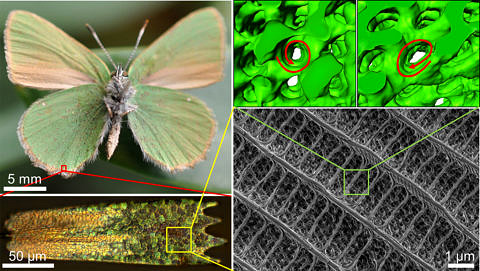Are butterflies right or left-handed?

FAU researchers answer key question on the microstructure of butterfly wings using electron tomography
FAU researchers have succeeded in pinpointing the three-dimensional structure of microscopic photonic crystals in butterfly wings. These findings will help researchers to understand the formation of periodic structures which affect the colouration of many butterflies. In the future, these findings could be pivotal in designing new optical materials.
Crystals rather than pigments
In contrast to paint, many butterflies do not get their colour from pigments, rather from hundreds of photonic crystals in the scales on their wings. Photonic crystals are regular structures of Chitin, a polysaccharide which is known for its structure forming properties. Diffraction and interference lead to only some of the light being reflected, which produce the colour and the shimmering effect. Photonic crystals are not only found in butterflies but also determine the iridescent colours of beetles and mussels.
Coincidence or not?
Photonic crystals found in some butterflies have a chirality or spiral structure – like a staircase – which is twisted to the right or left. These structures are referred to by scientists as right-handed or left-handed. A prominent example is the green hairstreak (Callophrys rubi) which is found across North Africa and Europe and has a chiral structure known as gyroid. To better understand the metamorphism of butterflies, it is important for evolution researchers to find out if the handedness of the chitin structure in the formation process of the butterfly occurs coincidentally or not. FAU materials scientists were now able to help answer this question.
In action: one of the most modern transmission electron microscopes in the world
The researchers led by Prof. Dr. Erdmann Spiecker at the Institute of Micro- and Nanostructure Research investigated the butterfly wings with the Titan3, one of the most modern transmission electron microscopes in the world at the Centre for Nanoanalysis and Electron Microscopy (CENEM) at FAU. In a similar process to computed tomography, the 3D structure of the object is reconstructed from a number of individual projections. By using fast electrons instead of X-rays, electron tomography exhibits a much better resolution. This meant that researchers were able to show for the first time that both handnesses occur in butterfly wings, however left-handed chirality is more common.
Findings disprove established models
The findings disprove established models which assumed that the formation of a specific chirality in the formation process is coincidental and suggest an even distribution of the occurring handednesses. “Evolution scientists now face the task of identifying molecular processes which lead to the preferred chirality. This is expected to bring groundbreaking insights into understanding metamorphism in butterflies and other insects. Such knowledge could be vital in the future in finding new ways for manufacturing innovative optical materials”, says Prof. Spiecker.
Results published in prestigious journal
The research findings which originated from a close collaboration within the Cluster of Excellence ‘Engineering of Advanced Materials’ between the FAU-based Institute of Micro and Nanostructure Research and the Chair for Theoretical Physics 1 (Prof. Dr. Klaus Mecke), as well as the School of Engineering and Information Technology at Murdoch University Australia (Prof. Dr. Gerd Schröder-Turk) have been published in the prestigious interdisciplinary journal Proceedings of the National Academy of Sciences of the United States of America (PNAS).
Further information:
Prof. Dr. Erdmann Spiecker
Phone: +49 9131 85 28603
erdmann.spiecker@fau.de